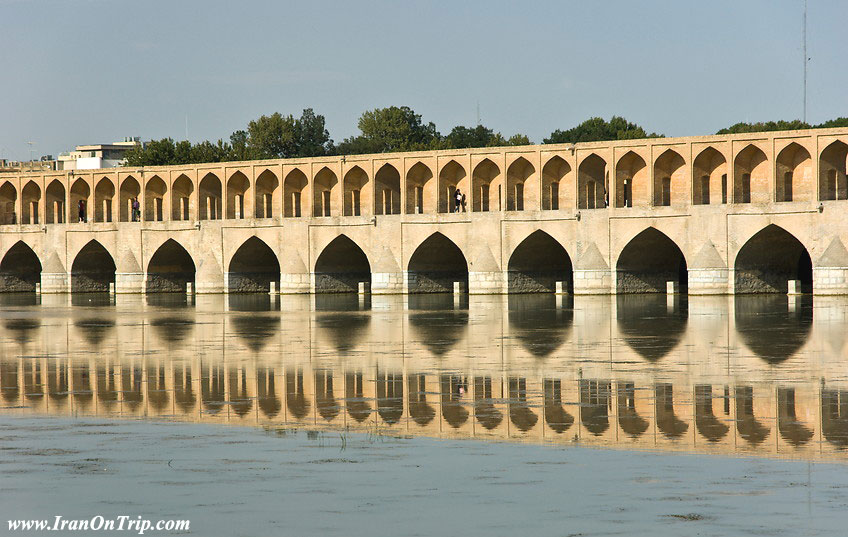Siosepol bridge-33 Pol-Allah Verdi Khan Bridge
.jpg)
Located in Esfahan (a city of Esfahan province)
Introduction:Siosepol bridge-33 Pol-Allah Verdi Khan Bridge-Siosepol- Si-o-Seh Pol(Persian: سی و سه پل)
The 33 Pol, or the Bridge or the Bridge of 33 Arches, also called the Allah Verdi Khan Bridge,
is one of the eleven bridges of Isfahan, Iran. It is highly ranked as being one of the most famous examples of Safavid bridge designs. According to some historical references concerning the buildings constructed during Shah Abbas the Safavid in Isfahan, it is so conceived that the construction work of this bridge was completed concurrent with the construction of Chahar Bagh in 1596. The bridge is made of bricks and stones.
Commissioned in 1602 by Shah Abbas I from his chancellor Allah Verdi Khan Undiladze, an Iranian ethnic Georgian, it consists of two rows of 33 arches. There is a larger base plank at the start of the bridge where the Zayandeh River flows under it. The bridge itself is 295 meters long and 13.75 meters wide. The thirty four piers on which it is constructed are 3.49 meters thick and the arches are 5.57 meters wide. Typical of the bridges of Isfahan, 33 Pol was designed as a social and contemplative space and not just a transportation structure. The bridge acted as a springboard for the development of the Khaju Bridge some 50 years later.

The bridge is built on a series of pontoons of great width and there is a famous tea-house amongst them which is accessible from the southern bank. The southern side of the bridge, where the waters of the Zayandeh run more swiftly has supplementary arches, and it is this that makes them suitable as a tea house. The lower level of 33 arches is surmounted by a second layer, with one arch above each of the pontoons and two arches above the lower single arch, giving it its name and rhythmic appearance. The road along the top is sandwiched between high walls which give some shelter from the wind as well as protection for travelers who can walk along the footpaths on either side to avoid traffic.
Dating years back, 33 Pol (and other points in Zayandeh River) has also been the site of the Abrizan celebration of Armenians. In this celebration the women would sit along the bridge while the men, wearing short and tight pants, would enter the river and proceed to splash each other with water. Complicating the continuation of this celebration, and the general preservation of this historical structure, in the summer of 2008 Zayandeh River dried out for the 2nd time in its history.
In 2004 it was announced that construction of the underground urban railway line in Isfahan's Chaharbagh district will be detrimental to the areas architecture and will lead to the destruction of Madreseh Chaharbagh and 33 Pol. The train movement would cause a shock equivalent to a tremor of two degrees on the Richter scale and Chahar-Bagh School and 33 Pol which are located along the route of the metro are in danger of gradually being destroyed. In 2007 urban officials of Isfahan announced the decision to divert the city’s underground railway line from Chaharbagh Street to Shamsabadi Street, although executors of the plan were undecided about it and suspended executive operations. Nevertheless and in spite of the efforts, Isfahan’s urban underground railway line was eventually extended from Chaharbagh to Shamsabadi Street, passing beneath Darvazeh Dolat and entering the Chaharbagh district.
.....
.....
.....

.jpg)



























